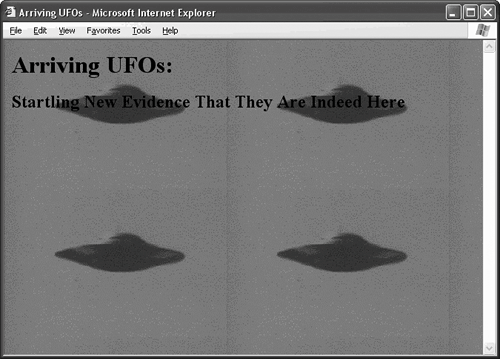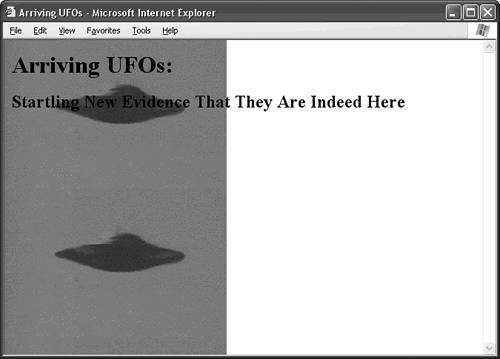Chapter 39. Using Background Images on Web Pages
| There are two ways to add a background image to a Web page. One is to use HTML attributes. The other is to use CSS style definitions. With HTML, you get limited design options but solid reliability across browsers. With CSS, you get more design options but less reliability.
In HTML, you add the background attribute to the body tag, like this: <body background="images/ufo.gif"> The browser tiles or repeats the image across all available real estate in the browser window, as in Figure 39.1. Figure 39.1. When you add a background image to the page with HTML, the browser automatically tiles the image to fill the page. Cascading Style Sheets produce the same effect: <body style="background-image: url(images/ufo.gif);"> The preceding example creates a tiling background image, exactly as in Figure 39.1. However, CSS gives you additional options to control exactly how the background image behaves, including background-repeat, background-position, and background-attachment. Use background-repeat to control how (or if) the background image tiles, as in Figure 39.2. Listing 39.1. View Source for Figure 39.2.<body style="background-image: url(images/ufo.gif); background-repeat: repeat-y;"> Figure 39.2. You can specify vertical-only tiling when you use CSS for background images. Determine where on the page the background image appears with the background-position attribute, as in Figure 39.3. Figure 39.3. Move the background image around the screen by including background-position in your style definition. The background-attachment attribute determines how the background image responds to scrolling. Set background-attachment to fixed to make the background image resist scrolling; that is, the background image remains rooted to its position in the browser window. The page content may scroll, but the background image does not, as in Figure 39.4. Listing 39.2. View Source for Figure 39.3.<body style="background-image: url(images/ufo.gif); background-repeat: repeat-y; background-position: right;"> Figure 39.4. With CSS, you can even make the background image impervious to scrolling. Listing 39.3. View Source for Figure 39.4.<body style="background-image: url(images/ufo.gif); background-repeat: no-repeat; background-position: right; background-attachment: fixed;"> To make the background image scroll with the rest of the page content, set background-attachment to scroll.
For your coding pleasure, Table 39.1 lists CSS options for background images.
|